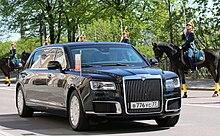This article needs additional citations for verification. (June 2019) |
 | |
| Formerly | Tractor Research Institution (1931–1946) |
|---|---|
| Company type | Federal state unitary enterprise |
| Founded | 1918 |
| Headquarters | , Russia |
| Revenue | $32.3 million[1] (2017) |
| −$35.3 million[1] (2017) | |
| $352,143[1] (2017) | |
| Total assets | $293 million[1] (2017) |
| Total equity | $16.6 million[1] (2017) |
| Website | nami |

The Central Scientific Research Automobile and Automotive Engines Institute, abbreviated as NAMI[a] is an organization in Russia in the field of automotive development. The institute was awarded the Order of the Red Banner of Labour.[2]
History
[edit]The research and development automobile and engine institute was established on 14 March 1920, based on the Scientific Automobile Laboratory (Russian: Научная автомобильная лаборатория (abbr. НАЛ)). The laboratory was part of the Scientific and Technical department of VSNKh, which was established on 16 October 1918. Starting in 1924, the institute allowed purchases of foreign automobiles and automobile accessories. In 1927 the institute developed its first automobile, the NAMI 1, which also became the first car of the USSR.

During the 1930s, the institute became the main department for development in the Soviet automotive industry. They later developed and produced the first Soviet trolleybuses, and created tractor and lorry models and. They also developed half-tracks and armored vehicles for the Red Army.
From 1931 to 1946 the institute was named the Automobile and Tractor Research Institution (NATI, Russian: Научно-исследовательский тракторный институт (abbr. НАТИ))
Early in 1946, NATI underwent a split, and the tractor division was transferred to be under the supervision of the Ministry of Agricultural Machinery. The automobile branch was kept under the supervision of the Ministry of Automobile Industry and was renamed the Scientific and Research Automobile and Engine Institute (NAMI, Russian: Научно-исследовательский автомобильный и автомоторный институт (НАМИ)). The tractor division later served as a basis for the Union Tractor Research Institution (NATI).
Experimental and prototype engines were developed at the institute, some of which served as the basis for later mass production. In the 1960s, NATI developed some front-wheel drive and automatic transmissions, but these concepts didn't make it to production until much later, as they were deemed too expensive and complex for the state of the industry at that time. For example, they developed the GAZ-21 automatic transmission, for which the service infrastructure was virtually non-existent.
Post-Soviet era
[edit]In 2014 the NAMI purchased the Yo-Mobile project for 1 Euro.[3]
In 2021, NAMI was involved in the design process the Aurus Senat car line, and developed a hydrogen powered model. A laboratory model was presented at its plant in Tatarstan in central Russia.[4][5]
In May 2022, NAMI acquired Renault's controlling stake (about 68%) in the Russian car manufacturer AvtoVAZ.[6]
Testing facility
[edit]In the 1960s the testing facility of NAMI (Russian: Научный испытательный центр автомобильной и мотоциклетной техники, НИЦИАМТ) was opened.
Prototypes
[edit]The 1920s and 1930s was the only period when NAMI was involved in vehicle production. Since then NAMI has only developed prototypes and concept cars.
|
|
Notable employee
[edit]Notes
[edit]- ^ [Государственный научный центр Российской Федерации Федеральное государственное унитарное предприятие "Центра́льный нау́чно-иссле́довательский автомоби́льный и автомото́рный институ́т] Error: [undefined] Error: {{Langx}}: missing language tag (help): transliteration text not Latin script (pos 136) (help)
References
[edit]- ^ a b c d e https://www.kartoteka.ru/card/08577cbf6b30d544d271fa3aa7cd5a87/0a91b41eb82d3aedc20480aef92092bb/.
{{cite web}}: Missing or empty|title=(help) - ^ "ГОСУДАРСТВЕННЫЙ НАУЧНЫЙ ЦЕНТР РФ ФГУП «НАМИ»". iasf.nami.ru. Retrieved 8 September 2022.
- ^ Прохоров продал права на «Ё-мобиль» за 1 евро Archived 12 April 2014 at the Wayback Machine
- ^ "Aurus Car Powered by Hydrogen Created in Russia | Power Systems Research". 27 June 2021.
- ^ "Aurus Introduced a Hydrogen Sedan with a Range of 600 Km".
- ^ Thompson, Mark (16 May 2022). "Renault sells Soviet-era icon Lada as it exits Russia, for now". Autocar. Retrieved 17 May 2022.